When it comes to dressing windows, homeowners are often faced with the age-old dilemma: blinds or curtains? Both serve the practical purpose of controlling light and privacy while adding aesthetic appeal to a room. However, each option comes with its own set of advantages and considerations. To make the best choice for your lifestyle, style, and practical needs, it’s important to know the differences between blinds and curtains.
Blinds: Sleek, Functional, And Modern
Blinds are window coverings made from slats or vans that can be tilted to control light and privacy. They come in various materials such as wood, faux wood, aluminium, and vinyl, offering versatility in style and function. Here’s a closer look at the benefits of choosing wholesale blinds:
1. Light Control: Blinds excel in providing precise light control. With adjustable slats, you can easily direct light upwards, downwards, or sideways, depending on your preference. This makes blinds ideal for rooms where you need flexibility in lighting, such as home offices or bedrooms, and even for rooms with unique lighting challenges like those with skylights or roof lanterns. For instance, roof lantern blinds can be adjusted to diffuse harsh sunlight while still allowing natural light to fill the space.
2. Privacy: The ability to tilt the slats allows for varying degrees of privacy without completely blocking out natural light. This makes blinds a practical choice for urban dwellings or rooms facing busy streets.
3. Modern Aesthetic: Blinds are often associated with a sleek and contemporary look, making them suitable for modern interior designs. They come in a range of colours and finishes to complement different decor styles, from minimalist to industrial.
4. Easy Maintenance: Cleaning blinds is relatively straightforward. Depending on the material, you can dust them with a microfiber cloth or vacuum them to keep them looking fresh. This convenience appeals to busy homeowners looking for low-maintenance window treatments.
5. Space Efficiency: Blinds take up less space compared to curtains, especially when mounted inside the window frame. This can be advantageous in smaller rooms or where windows are close to furniture or walkways.
Curtains: Versatile, Elegant, And Decorative
Curtains, on the other hand, are long pieces of fabric that hang from above the window on a rod or track. They offer a softer, more traditional window treatment option with unique advantages:
1. Insulation And Sound Absorption: Blinds don’t insulate as well as curtains do. In the winter, curtains trap heat in the room, and in the summer, they block sunshine. Additionally, thicker curtains can reduce outside noise, making them beneficial for bedrooms and living rooms.
2. Versatility In Design: With endless fabric choices, patterns, and textures, curtains offer unparalleled versatility in enhancing a room’s decor. They can create a focal point, add warmth, or complement existing furnishings, allowing for more personalized interior styling.
3. Light Filtering And Blackout Options: Curtains come in various opacities, from sheer to blackout, offering flexible light filtering options. Sheer curtains let in diffused light while maintaining privacy, while blackout curtains are ideal for bedrooms or media rooms where complete darkness is desired.
4. Softening Effect: Curtains soften the overall look of a room and add a sense of coziness and luxury. They create a sense of height and depth, making windows appear larger and rooms more inviting.
5. Easy Customization: Customizing curtains is relatively easy. You can adjust the length, add linings for insulation, or choose decorative hardware like rods and finials to match your decor style perfectly.
Choosing Between Blinds And Curtains: Key Considerations
Deciding between blinds and curtains ultimately depends on your specific needs and preferences. Here are some factors to consider:
1. Room Functionality: Assess how you use the room. For example, home offices may benefit from blinds for precise light control, while living rooms might favour curtains for their decorative appeal and light-filtering options.
2. Interior Style: Consider your decor style and the ambience you want to create. Blinds suit modern and minimalist interiors, while curtains are versatile enough to complement traditional, eclectic, or contemporary decor.
3. Privacy And Light Control: Determine how much privacy and light control you need. Blinds offer adjustable slats for precise control, whereas curtains provide varied opacities to suit different lighting preferences.
4. Maintenance: Evaluate your preference for maintenance. Blinds are generally easier to clean, but curtains offer more customization options and can be laundered or dry-cleaned depending on the fabric.
5. Budget: Compare costs between blinds and curtains, considering factors like material, size, and customization. Blinds made from wood or specialty fabrics can be more expensive upfront, whereas curtains vary widely in price depending on fabric and style.
Conclusion
In conclusion, both blinds and curtains offer distinct advantages depending on your lifestyle, aesthetic preferences, and practical needs. Blinds provide modern functionality, space efficiency, and easy maintenance, making them ideal for contemporary interiors and rooms that require precise light control. On the other hand, curtains offer versatility in design, better insulation, and a softer aesthetic, enhancing the decor of traditional and eclectic spaces.
When deciding between blinds and curtains, consider the specific requirements of each room, your style, and the ambience you wish to achieve. By weighing these factors carefully, you can confidently choose the window treatment that not only complements your home but also enhances your overall living experience.



